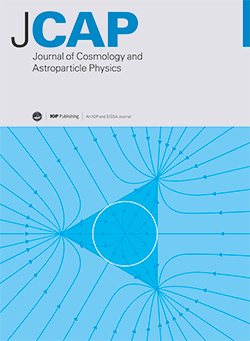不对称暗物质在现实恒星和行星中的热传导模拟
IF 5.3
2区 物理与天体物理
Q1 ASTRONOMY & ASTROPHYSICS
Journal of Cosmology and Astroparticle Physics
Pub Date : 2025-06-23
DOI:10.1088/1475-7516/2025/06/047
引用次数: 0
摘要
在恒星中捕获的暗物质可以作为一种额外的热传输机制,改变聚变速率和星震观测结果。热传递率的计算依赖于玻尔兹曼方程的近似解,这在现实的恒星中从未得到验证。在这里,我们利用真实的径向温度、密度、成分和引力势剖面,模拟了太阳、地球和褐矮星模型中的热传输。我们表明,在ref.[1]中开发的形式主义在考虑的所有天体中仍然是准确的,在广泛的运动学制度下,对于自旋依赖和自旋独立的相互作用,多物种散射变得重要。我们进一步研究了太阳暗物质的蒸发速率,发现之前的计算似乎是可靠的。我们的蒙特卡罗模拟软件cosmion是公开的:https://github.com/aaronvincent/cosmion。本文章由计算机程序翻译,如有差异,请以英文原文为准。
Simulation of thermal conduction by asymmetric dark matter in realistic stars and planets
Dark matter captured in stars can act as an additional heat transport mechanism, modifying fusion rates and asteroseismoloigcal observables. Calculations of heat transport rates rely on approximate solutions to the Boltzmann equation, which have never been verified in realistic stars. Here, we simulate heat transport in the Sun, the Earth, and a brown dwarf model, using realistic radial temperature, density, composition and gravitational potential profiles. We show that the formalism developed in ref. [1] remains accurate across all celestial objects considered, across a wide range of kinematic regimes, for both spin-dependent and spin-independent interactions where scattering with multiple species becomes important. We further investigate evaporation rates of dark matter from the Sun, finding that previous calculations appear robust. Our Monte Carlo simulation software cosmion is publicly available: https://github.com/aaronvincent/cosmion.
求助全文
通过发布文献求助,成功后即可免费获取论文全文。
去求助
来源期刊

Journal of Cosmology and Astroparticle Physics
地学天文-天文与天体物理
CiteScore
10.20
自引率
23.40%
发文量
632
审稿时长
1 months
期刊介绍:
Journal of Cosmology and Astroparticle Physics (JCAP) encompasses theoretical, observational and experimental areas as well as computation and simulation. The journal covers the latest developments in the theory of all fundamental interactions and their cosmological implications (e.g. M-theory and cosmology, brane cosmology). JCAP''s coverage also includes topics such as formation, dynamics and clustering of galaxies, pre-galactic star formation, x-ray astronomy, radio astronomy, gravitational lensing, active galactic nuclei, intergalactic and interstellar matter.
 求助内容:
求助内容: 应助结果提醒方式:
应助结果提醒方式:


